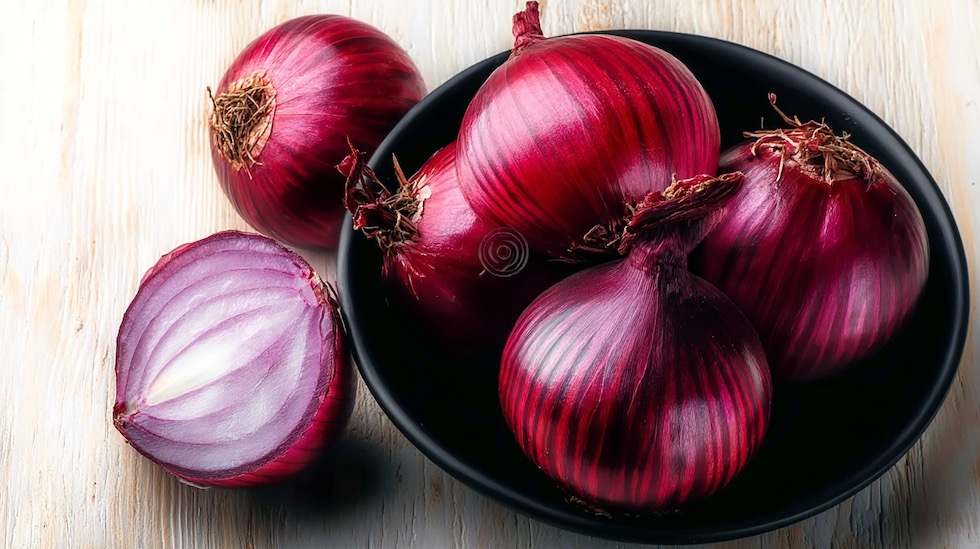Red onion – the tear-jerking kitchen star
There’s no question that red onions are an essential addition to your kitchen if you love flavour, colour and versatility. Many people simply call it ‘mild onion’ (although not quite right), but you may also know it by other names such as salad onion or purple onion. The official, scientific name: Allium cepa var. aggregatum .

This particular plant belongs to the onion family and originated in Central Asia. It was known and consumed by the ancient Egyptians and was even revered as a sacred plant. From there it spread to Europe via the Mediterranean and today we can’t imagine our meals without it.
Importance in the kitchen: 5/5
It is no exaggeration to say that red onions are a staple food. Whether it’s a cold dish, a salad, a pickle or a grilled dish, this aromatic vegetable adds something extra to everything. It’s a real favourite in Europe and especially in Hungary. Its colour is also beautiful, so it adds a lot to a dish, not only in terms of taste but also in terms of visual appeal.
Which parts are edible and which are not?
The edible part of the red onion is the bulb body, which develops underground and is multi-layered, juicy and slightly pungent in flavour. The outer, dry skin is not usually eaten, nor is the root part. The green sprouts are also edible, especially when tender, but the purple bulbous head is most commonly used for cooking. Important: it is best to avoid mouldy, discoloured or soft specimens!
Health on the table – what does the red onion do?
This vegetable is full of valuable nutrients: vitamin C, vitamin B6, folic acid and antioxidant compounds. The anthocyanins, which give it its purple colour, have anti-inflammatory and cardioprotective properties. In folk medicine it has been used to treat colds, coughs and even as a blood purifier. It also aids digestion and is known to have a natural blood sugar lowering effect.
Growing curiosities and season
It is grown throughout Europe, mainly in Italy, Spain and the Netherlands. It is also grown in Hungary, mainly in Bács-Kiskun and Csongrád-Csanád counties. The season lasts from the end of July to September, but it is available in storable form all year round. In shops, you can find fresh, home-grown red onions from spring to autumn, while in the winter months they are often imported (mainly from Spain and the Netherlands).
How to choose a good red onion?
- Good quality red onions are firm to the touch, not dented or soft.
- The skin should be evenly coloured, undamaged and dry.
- Avoid mouldy, spongy or cracked pieces!
The selection is not difficult, but it is worth looking closely at the skin and smelling it: if it smells too strong, it may already be decaying.
How to store it wisely
The red onion does not like the fridge. It is best stored in a cool, dry, ventilated place – for example, in a pantry or pantry. Do not put it in a damp environment, as it moulds easily. Once cut, it will keep for 2-3 days in the fridge in an airtight container.
International careers: how are they used elsewhere?
- In Mexico: marinated in lemon juice and served with tacos or burritos.
- In Greece: it is served in a salad with feta, tomatoes and olives.
- In India: an important ingredient in battniks and curries.
- In the USA: in barbecue sandwiches, hamburgers and coleslaw salads.
Classic recipe: red onion jam
For something really special, try the red onion marmalade. It’s perfect with roasted meat, cheese or in sandwiches.
- 4-5 large heads of red onion
- 2 tablespoons olive oil
- 2 tablespoons brown sugar
- 1 tablespoon of balsamic vinegar
- pinch of salt, freshly ground pepper
Thinly slice the onion and caramelise it with the sugar in the oil over a low heat. When it becomes translucent and sweet-smelling, add the vinegar, salt and pepper and cook over a low heat. When cooled, it can be stored in a jar and will keep for weeks.
How to use it in the kitchen – tips and tricks
- Fresh, raw: in salads, sandwiches, with cheese.
- Pickled: excellent for cold dishes in a vinegar and sugar bath.
- Baked: slowly caramelised, delicious with meats and pasta.
- As a jam: a special addition to cheeses and meats.
Spices that you can use: rosemary, thyme, balsamic vinegar, pepper, honey. However, too many strong peppers or strong curries can overpower the flavour unnecessarily – use these with caution.
Whether it’s for everyday cooking or a festive menu, red onions are a sure thing in the kitchen – delicious, healthy and showy. Don’t be afraid to experiment with it, the end result is almost always worth it! 🧅✨
